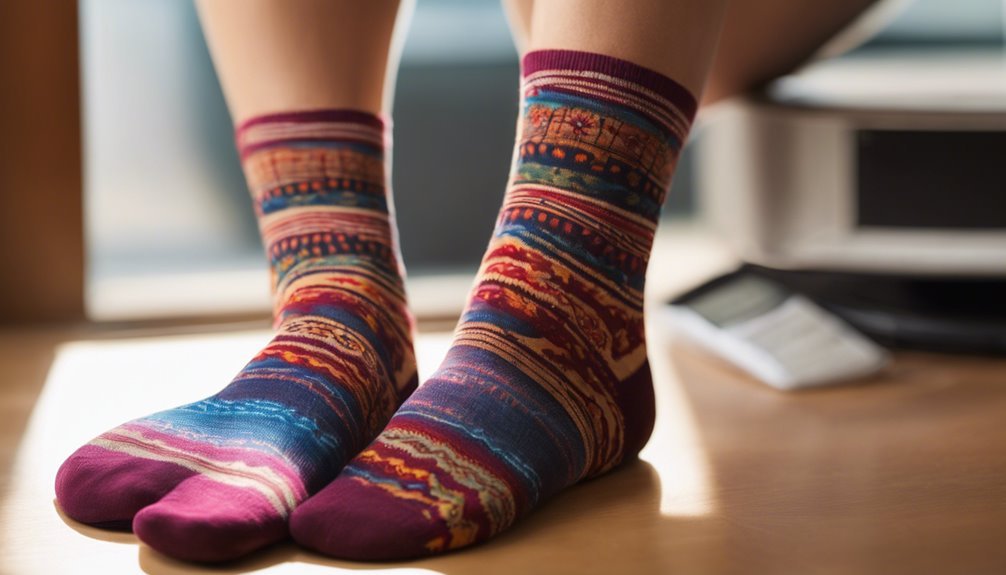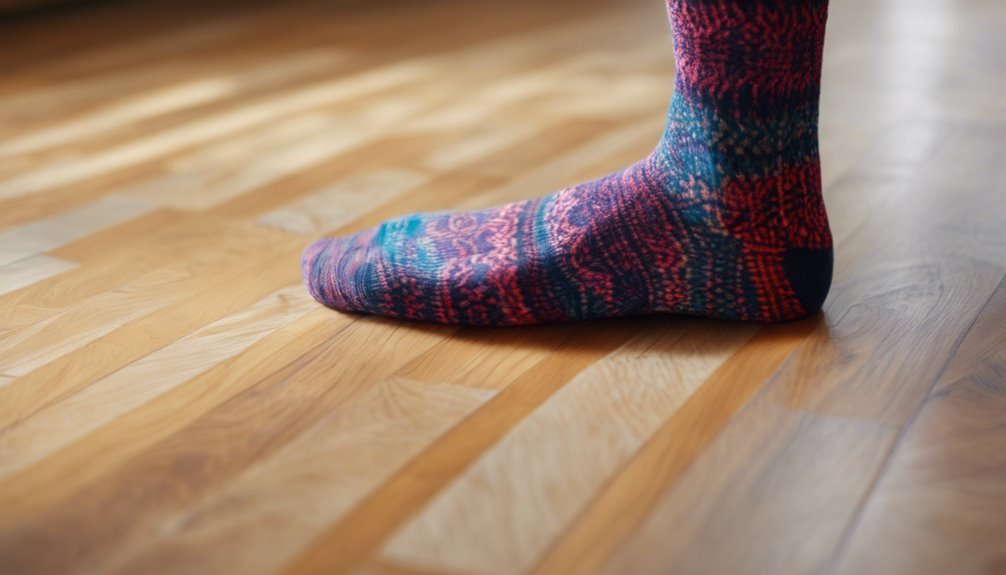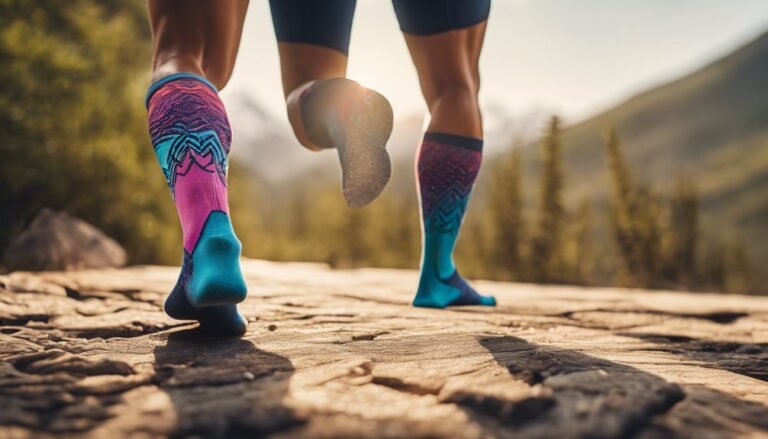Do Socks Really Affect Blood Circulation?
Yes, socks can really affect your blood circulation. The right pair, especially compression socks, offers gentle support that helps prevent blood pooling. However, tight socks can constrict circulation, causing numbness or discomfort. Proper fit and suitable materials—like moisture-wicking fabrics—are essential for promoting healthy blood flow. For specific conditions like varicose veins or deep vein thrombosis, specialized sock choices can make a difference. Learn how to choose the best socks for your needs.
Understanding Blood Circulation

Understanding blood circulation is crucial because it plays an important role in your overall health. Blood flow guarantees that oxygen and nutrients reach every part of your body, allowing it to function at its best. When circulation is compromised, it can lead to serious health issues, including cardiovascular diseases and diminished vascular health.
Maintaining good blood flow is essential for minimizing the risk of blood clots and guaranteeing your organs receive adequate support. Engaging in regular exercise, staying hydrated, and managing stress can greatly enhance your circulation. Additionally, being aware of factors that can hinder blood flow, such as prolonged sitting or smoking, helps you take proactive steps towards better vascular health. Prioritizing these aspects empowers you to enhance your well-being and live freely.
How Socks Can Impact Circulation
While you might not think about it often, the type of socks you wear can actually influence your blood circulation. Socks with good sock elasticity can provide gentle compression, which helps enhance circulation, especially during prolonged periods of sitting or standing. This compression supports your veins and can prevent blood from pooling, reducing the risk of swelling or discomfort. On the other hand, overly tight or restrictive socks can hinder blood flow, potentially leading to numbness or other circulation issues. Choosing socks designed for circulation enhancement, like compression socks, can be beneficial, especially for those with specific health concerns. So, when you pick your socks, consider how they might affect your overall blood circulation and comfort throughout the day.
The Importance of Sock Fit
A proper fit is essential when it comes to socks, as wearing the wrong size can lead to discomfort and circulation issues. Sock sizing plays a significant role in your overall comfort; socks that are too tight can constrict blood flow, while those that are too loose may bunch up, causing friction and irritation. Pay attention to how elastic bands fit around your calves; overly tight bands can create indentations and restrict circulation. Always choose socks that provide a snug fit without pinching or cutting into your skin. By prioritizing the right sock fit, you'll enjoy better comfort and improved circulation, allowing you the freedom to move without worry. Don't underestimate the power of the perfect pair of socks!
Materials That Affect Circulation

Choosing the right materials for your socks can greatly impact blood circulation. When deciding between cotton vs. synthetic fabrics, consider how each affects moisture management. Cotton absorbs moisture but can retain it, leading to discomfort and potential swelling. On the other hand, synthetic materials like polyester or nylon wick away moisture, keeping your feet dry and reducing the risk of circulation issues.
Additionally, synthetic options often provide better elasticity, allowing for a snug fit without constricting blood flow. This balance is essential; while you want your socks to stay in place, you don't want them to be too tight. Ultimately, opting for moisture-wicking synthetic socks can enhance comfort and promote better circulation, giving you the freedom to move without restrictions.
Health Conditions and Sock Choices
When choosing socks, it's crucial to reflect on your health conditions, as certain types can greatly impact circulation. Compression socks, for example, can provide essential support for those with venous issues, while the material of your socks may also influence blood flow. Ensuring a proper fit and comfort is equally important to avoid restricting circulation further.
Compression Sock Benefits
While you might not think about your socks affecting your health, compression socks can play an essential role in improving blood circulation, particularly for individuals with specific health conditions. They offer various benefits through compression therapy, which helps reduce swelling and enhances venous return.
| Health Condition | Recommended Sock Types | Benefits |
|---|---|---|
| Varicose veins | Knee-high compression socks | Alleviates discomfort and swelling |
| Deep vein thrombosis | Thigh-high compression socks | Prevents blood clots |
| Edema | Ankle-length compression socks | Reduces fluid retention |
| Athletic performance | Graduated compression socks | Enhances recovery and endurance |
Choosing the right sock type for your condition can notably impact your comfort and mobility, allowing you to embrace life freely.
Material Impact on Circulation
The materials used in socks can greatly influence blood circulation and overall comfort, particularly for those with specific health conditions. Choosing the right sock materials not only impacts comfort but also can help with circulation effects. Here are some materials to take into account:
- Cotton: Breathable but may retain moisture, potentially affecting circulation.
- Wool: Insulating and moisture-wicking, good for temperature regulation.
- Bamboo: Soft, hypoallergenic, and moisture-absorbing, promoting healthy circulation.
- Nylon/Spandex blends: Provide elasticity and compression, beneficial for circulation.
- Compression fabrics: Specifically designed to enhance blood flow, essential for certain health conditions.
When you're aware of how sock materials affect your feet, you can make better choices for your health and comfort.
Fit and Comfort Importance
Choosing the right fit and comfort level in socks is essential, especially if you have health conditions that affect circulation. An improper sock size can lead to constriction, restricting blood flow and causing discomfort. It's vital to select socks that fit snugly but aren't too tight. Look for options that provide adequate cushioning and breathability, enhancing your overall comfort level. If you suffer from conditions like diabetes or peripheral artery disease, prioritize socks designed for sensitive feet, which often feature non-binding tops and moisture-wicking properties. Remember, comfort isn't just about feeling good; it's about promoting healthy circulation. By choosing the right sock size and focusing on comfort, you can help maintain ideal blood flow and enhance your well-being.
Tips for Choosing the Right Socks
Finding the right socks can greatly impact your comfort and circulation. With so many sock styles and fabric blends available, it's crucial to choose wisely. Here are some quick tips to help you find the perfect pair:
- Consider the material: Look for breathable fabrics like cotton or moisture-wicking blends.
- Check the fit: Verify they aren't too tight or too loose to avoid restricting blood flow.
- Look for cushioning: Extra padding can enhance comfort, especially for active lifestyles.
- Choose the right height: Decide between ankle, crew, or knee-high based on your activity.
- Think about compression: If you have circulation concerns, consider compression socks for added support.
Frequently Asked Questions
Can Wearing Socks During Sleep Improve Circulation?
Imagine cozy socks hugging your feet as you drift into dreamland. Wearing them during sleep can enhance circulation, helping you wake refreshed. The benefits of socks extend beyond warmth; they also support healthy sleep circulation.
Do Compression Socks Work for Everyone?
Compression socks don't work for everyone. While they offer benefits like improved circulation and reduced swelling, some may experience risks, such as skin irritation or improper fit. Always consult a healthcare professional for personalized advice.
How Often Should I Replace My Socks?
You should replace your socks regularly, ideally every six months. Consider sock material and thickness; worn-out socks lose elasticity and comfort. Fresh socks provide better support, enhance your freedom of movement, and keep your feet happy.
Are There Specific Brands Recommended for Circulation?
When choosing socks, look for brands offering compression styles and breathable materials like cotton or moisture-wicking blends. These features can enhance comfort and potentially improve circulation, giving you the freedom to stay active longer.
Can Tight Socks Cause Long-Term Circulation Issues?
Imagine your feet wrapped too tightly in a vice; sock tightness can indeed lead to circulation problems over time. If they pinch, consider switching to looser options to maintain healthy blood flow and comfort.







